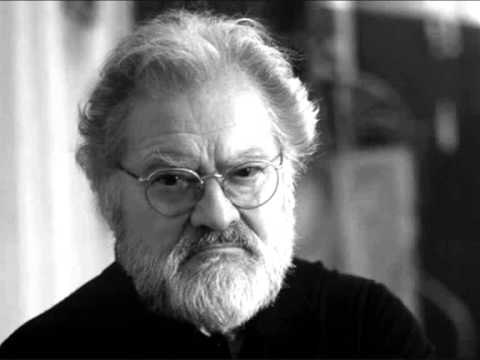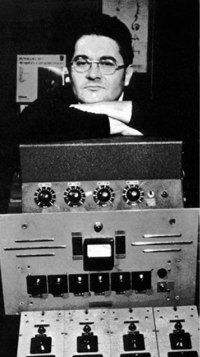
Pierre Henry was born in Paris, France, and began experimenting at the age of 15 with sounds produced by various objects. He became fascinated with the integration of noise into music. He studied with Nadia Boulanger, Olivier Messiaen, and Félix Passerone at the Paris Conservatoire from 1938 to 1948 (Dhomont 2001).
Between 1949 and 1958, Henry worked at the Club d’Essai studio at RTF, which had been founded by Pierre Schaeffer in 1943 (Dhomont 2001). During this period, he wrote the 1950 piece Symphonie pour un homme seul, in cooperation with Schaeffer; he also composed the first musique concrète to appear in a commercial film, the 1952 short film Astrologie ou le miroir de la vie. Henry has scored numerous additional films and ballets.
Why did I suddenly want to start to work with a new musical universe? This was at practically the end of my formal musical studies. I have said it many times and I will tell it again now: I started to listen to the world around me, outside and in my parents’ garden, inside the house where I had started my musical studies at the piano and vocal scales. Well, all of it must have been due to my fondness for noises. I had started my career as a percussionist quite early, beating on anything around me; furniture, the tables, the drums. I arrived at the moment of creating a noise, and went on to create something entirely new, an unheard sound that was much more complex and extraordinary. At the beginning I wanted very much to create something strange.
… these new structures, the way you say it, that’s like putting the horse behind the cart. One of course has to compose with a direction, a lucid idea. One has to have in mind a certain construction, a form. But that form differs according to the theme, to the character of the work and of course according to the material. A work like Le Voyage [a piece based almost entirely on feedback – IS] has a form, another like La Porte another one. And another work that requires a voice or chanting … every work has its form, but this form is there in the art of creation. I think that from the beginning of my work I have been more original in my form than in my material.
 … my work is so varied that there are works where sounds are exposed with their tempered notes like La Noire à Soixante and others which are truly life; the development of sound and its multiplication, its transformation, its mutation, I think that is the better word for it, like in Le Livre de Morts Egyptien. There are sometimes no laws, basically. My sounds are sometimes ideograms. The sounds need to disclose an idea, a symbol … I often very much like a psychological approach in my work, I want it to be a psychological action, with a dramatic or poetic construction or association of timbre or, in relation to painting, of colour. Sounds are everywhere. They do not have to come from a library, a museum. The grand richness of a sound palette basically determines the atmosphere. At the moment I try to manufacture a certain ‘tablature de serie’. I won’t talk about it. I almost become a late serialist. After a big vehement expressive period, post-romantic, I think that now I’m going into a period of pure ideas. It all reminds me very much of my work of the 50s.
… my work is so varied that there are works where sounds are exposed with their tempered notes like La Noire à Soixante and others which are truly life; the development of sound and its multiplication, its transformation, its mutation, I think that is the better word for it, like in Le Livre de Morts Egyptien. There are sometimes no laws, basically. My sounds are sometimes ideograms. The sounds need to disclose an idea, a symbol … I often very much like a psychological approach in my work, I want it to be a psychological action, with a dramatic or poetic construction or association of timbre or, in relation to painting, of colour. Sounds are everywhere. They do not have to come from a library, a museum. The grand richness of a sound palette basically determines the atmosphere. At the moment I try to manufacture a certain ‘tablature de serie’. I won’t talk about it. I almost become a late serialist. After a big vehement expressive period, post-romantic, I think that now I’m going into a period of pure ideas. It all reminds me very much of my work of the 50s.
 Sources
Sources
Dhomont, Francis. 2001. “Henry, Pierre”. The New Grove Dictionary of Music and Musicians, second edition, edited by Stanley Sadie and John Tyrrell. London: Macmillan Publishers.
Interview and text are by Ios Smolders, and originally appeared in issue 44 of Vital magazine, in 1995. The online version has been slightly edited by Brian Duguid; some quotes by Ios, Henry and Michel Chion have been altered to make them read better in English.
